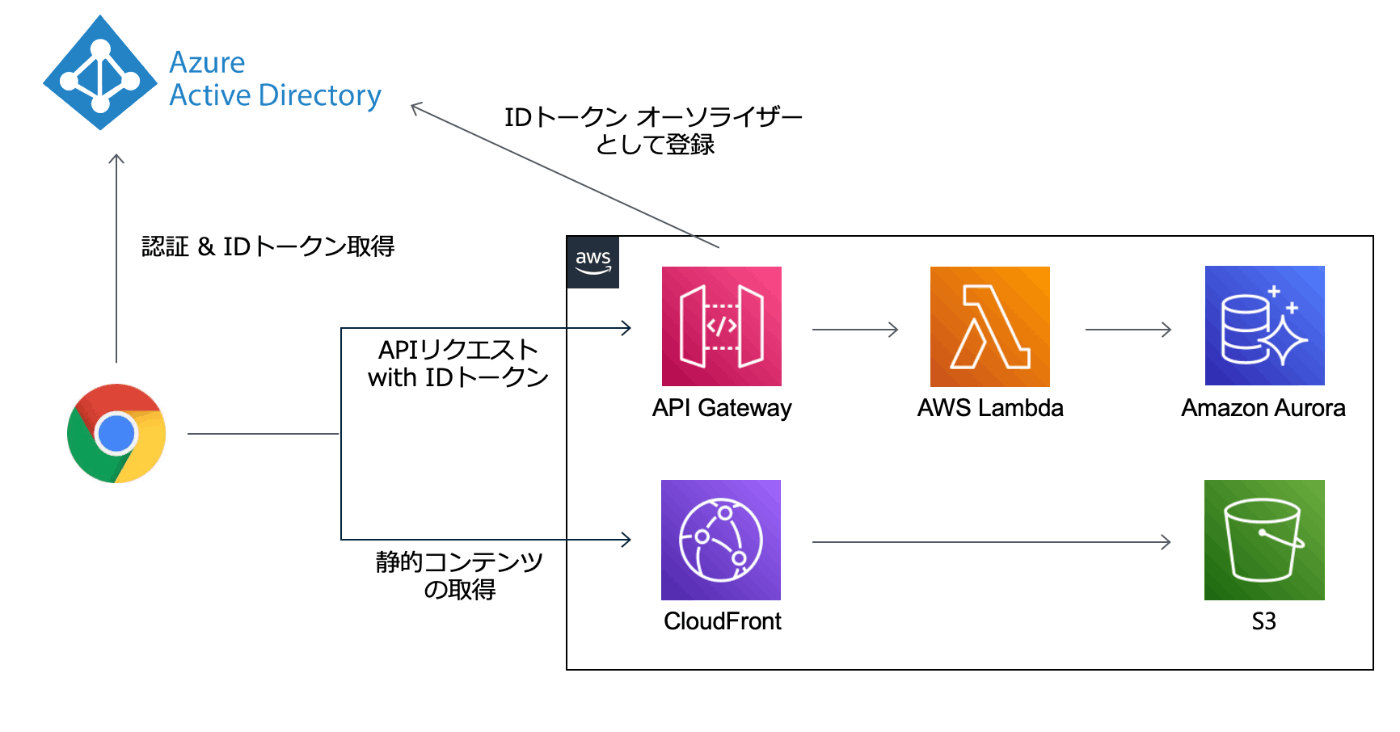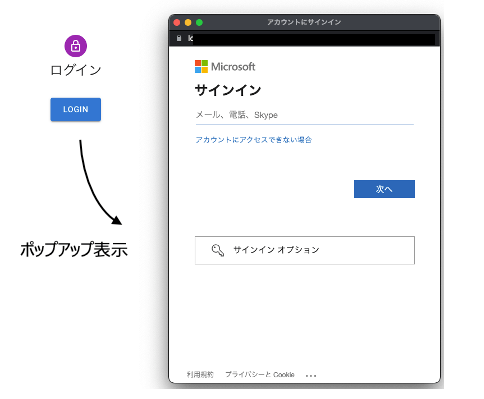CDK v2 でAzureADとOIDC連携するAPI Gateway - Lambdaを作成する
背景
AzureADに登録されている特定のユーザーだけにwebAPI叩かせたい時ってありますよね。
色々調べると、API Gateway v2 (HTTP API)ではかなり楽にIdPと連携できるようになっていたので、存分にその恩恵を享受しました。
さて、いい感じに出来たし、CDKで構築しますか
↓
CDK v2の記事全然ねえ....
ということで備忘録を兼ねてまとめておきます。
詳しく書かないこと
- OIDC認証について
- ReactアプリとAzureAD連携の部分
構成

AzureAD
連携するアプリをクライアントとして登録します。
書きたいことは山程ありますが、、割愛!AzureAD GUIのクセがすごいんじゃ。
フロントエンド
create-react-appで作成。npm buildした成果物をS3に配置し、cloudfrontで提供。
まずログイン画面を表示し、AzureADでの認証に成功するとIDトークンの取得を行うようにした。

reactアプリとAzureADの連携は、MicroSoft Authenticate Library(MSAL)にお世話になりました。機会があれば紹介します。
取得したIDトークンはただの文字列なので、axiosでheaderに載せてAPIアクセスを行います。
const response = await axios
.get(`${API_URL}`, {
headers: {
Authorization: `Bearer ${idToken}`,
},
})
.catch((error) => {...})
ここでのBearerはBearerトークンであることの意思表示です。
Bearerトークンは持参人トークンというピンとこない日本語で呼ばれており、「トークンさえ持っていれば、その持ち主の検証はしない。」ということを意味しています。(切符みたいなものですね)
バックエンド
API Gateway v2 & lambda & RDSの基本的な構成を採用。JWTオーソライザーとしてIdPを簡単に登録できるのでREST APIではなくHTTP APIにしました。
API Gatewayにおいて、ヘッダーで受け取ったIDトークンの検証をAzureADと連携して行い、
AzureAD上に登録されたユーザーからのリクエストであれば後続のlambdaを呼び出します。
不正なIDトークンの場合は401 Unauthorizedを返します。
これにより、lambda上でIDトークンの検証を行う必要がなくなります。
lambdaからはAurora serverlessクラスターにクエリを投げます。
AuroraはVPC&private subnetが必要なので、そのあたりも適宜用意します。
環境
$ cdk --version
2.16.0 (build 4c77925)
バックエンドのCDKコード
例として https://API_ROOT_URL/name に対するGETリクエストのAPIを作成します。
とりあえずコード全体はこちら。
import {
Stack,
StackProps,
Duration,
aws_lambda as lambda,
aws_ec2 as ec2,
aws_rds as rds,
} from "aws-cdk-lib";
import * as apigw from "@aws-cdk/aws-apigatewayv2-alpha";
import { HttpLambdaIntegration } from "@aws-cdk/aws-apigatewayv2-integrations-alpha";
import { Construct } from "constructs";
import * as path from "path";
export class CdkStack extends Stack {
constructor(scope: Construct, id: string, props?: StackProps) {
super(scope, id, props);
// Aurora用VPCの定義
const vpc = new ec2.Vpc(this, "Vpc", {
cidr: VPC_CIDR,
// privatesubnetのみ作成。isolatedなので、NAT Gatewayも作られない。
subnetConfiguration: [
{
cidrMask: 26,
name: "rds",
subnetType: ec2.SubnetType.PRIVATE_ISOLATED,
},
],
maxAzs: 2,
vpcName: "vpcName",
});
// Aurora serverlessの定義
const cluster = new rds.ServerlessCluster(this, "Cluster", {
engine: rds.DatabaseClusterEngine.AURORA_MYSQL,
vpc,
parameterGroup: rds.ParameterGroup.fromParameterGroupName(
this,
"ParameterGroup",
"default.aurora-mysql5.7"
),
scaling: {
autoPause: Duration.minutes(10),
minCapacity: rds.AuroraCapacityUnit.ACU_1,
maxCapacity: rds.AuroraCapacityUnit.ACU_2,
},
enableDataApi: true,
vpcSubnets: {
subnetType: ec2.SubnetType.PRIVATE_ISOLATED,
},
});
// API Gatewayの定義
const httpApi = new apigw.HttpApi(this, "httpApi", {
apiName: "apiName",
corsPreflight: {
allowHeaders: ["Authorization", "Content-Type"],
allowMethods: [
apigw.CorsHttpMethod.GET,
apigw.CorsHttpMethod.POST,
apigw.CorsHttpMethod.OPTIONS,
],
allowOrigins: ["*"],
maxAge: Duration.seconds(300),
},
});
// API Gateway Authorizerの定義
const httpApiAuthorizer = new apigw.HttpAuthorizer(
this,
"httpApiAuthorizer",
{
httpApi: httpApi,
identitySource: ["$request.header.Authorization"],
type: apigw.HttpAuthorizerType.JWT,
authorizerName: "AzureAD",
// アプリケーションIDを指定
jwtAudience: [JWT_AUDIENCE],
// JWTのIssuerを指定
jwtIssuer: JWT_ISSUER,
}
);
// 何故かhttpApiAuthorizerはaddRoutesのauthorizerに渡せないので、渡せる形式に変換
const iHttpRouteAuthorizer =
apigw.HttpAuthorizer.fromHttpAuthorizerAttributes(
this,
"iHttpRouteAuthorizer",
{
authorizerId: httpApiAuthorizer.authorizerId,
authorizerType: "JWT",
}
);
// APIのlambda
const getNameLambda = new lambda.Function(
this,
"get-name-lambda",
{
runtime: lambda.Runtime.PYTHON_3_9,
handler: "getName.lambda_handler",
code: lambda.Code.fromAsset(path.join(__dirname, "../lambda")),
environment: {
CLUSTER_ARN: cluster.clusterArn,
SECRET_ARN: cluster.secret!.secretArn,
},
functionName: "get-name",
timeout: Duration.minutes(2),
}
);
cluster.grantDataApiAccess(getNameLambda);
// API path指定
httpApi.addRoutes({
path: "/name",
methods: [apigw.HttpMethod.GET],
integration: new HttpLambdaIntegration(
"get-name-integration",
getNameLambda
),
// JWT認証のオーソライザーを定義
authorizer: iHttpRouteAuthorizer,
});
API Gateway向けライブラリのimport
まだstableではないので-alphaライブラリからimport
import * as apigw from "@aws-cdk/aws-apigatewayv2-alpha";
import { HttpLambdaIntegration } from "@aws-cdk/aws-apigatewayv2-integrations-alpha";
API Gateway
素直に設定していく。CORS設定はcorsPreflightに詰めていく。allowMethodsは適宜修正する。
const httpApi = new apigw.HttpApi(this, "httpApi", {
apiName: "apiName",
corsPreflight: {
allowHeaders: ["Authorization", "Content-Type"],
allowMethods: [
apigw.CorsHttpMethod.GET,
apigw.CorsHttpMethod.POST,
apigw.CorsHttpMethod.OPTIONS,
],
allowOrigins: ["*"],
maxAge: Duration.seconds(300),
},
}
);
API Gateway Authorizer
JWTオーソライザーの設定。
jwtAudienceはAzureAD上で登録したアプリケーションのアプリケーション(クライアント)ID、
jwtIssuerは https://login.microsoftonline.com/{AzureADのテナントID}/v2.0
これらはIDトークンをデコードして、audとissから取得することも出来る。
// API Gateway Authorizerの定義
const httpApiAuthorizer = new apigw.HttpAuthorizer(
this,
"httpApiAuthorizer",
{
httpApi: httpApi,
identitySource: ["$request.header.Authorization"],
type: apigw.HttpAuthorizerType.JWT,
authorizerName: "AzureAD",
// アプリケーションIDを指定
jwtAudience: [JWT_AUDIENCE],
// JWTのIssuerを指定
jwtIssuer: JWT_ISSUER,
}
);
更に、定義したauthorizerをimportし、httpApiで受け取れる変数(iHttpRoute型)に変換する
const iHttpRouteAuthorizer =
apigw.HttpAuthorizer.fromHttpAuthorizerAttributes(
this,
"iHttpRouteAuthorizer",
{
authorizerId: httpApiAuthorizer.authorizerId,
authorizerType: "JWT",
}
);
lambdaの定義
RDSにアクセスするための権限を付与するのを忘れない(忘れた)
// APIのlambda
const getNameLambda = new lambda.Function(
this,
"get-name-lambda",
{
runtime: lambda.Runtime.PYTHON_3_9,
handler: "getName.lambda_handler",
code: lambda.Code.fromAsset(path.join(__dirname, "../lambda")),
// DataApiでアクセスするので、自動生成されるclusterArnとsecretArnを渡してあげればOK
environment: {
CLUSTER_ARN: cluster.clusterArn,
SECRET_ARN: cluster.secret!.secretArn,
},
functionName: "get-name",
timeout: Duration.minutes(2),
}
);
// DataApiへのアクセス権限をlambdaに付与!!!
cluster.grantDataApiAccess(getNameLambda);
APIの定義
addRoutesメソッドでAPIを追加していく。
authorizerにはiHttpRoute型の変数を渡してあげる。
// API path指定
httpApi.addRoutes({
path: "/name",
methods: [apigw.HttpMethod.GET],
integration: new HttpLambdaIntegration(
"get-name-integration",
getNameLambda
),
// JWT認証のオーソライザーを定義
authorizer: iHttpRouteAuthorizer,
});
最後に
v2の情報は本当に少ないですね、、、
どなたかの役に立てば嬉しいです。
Discussion